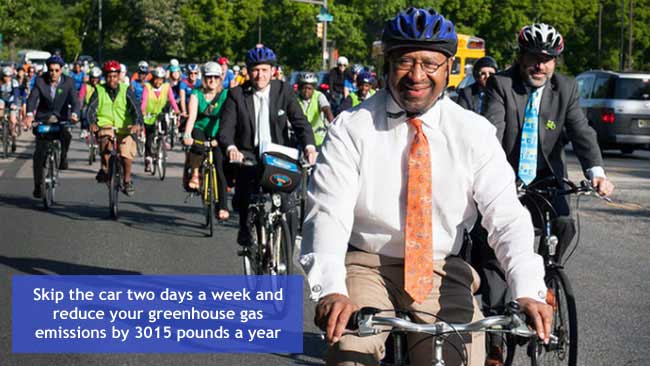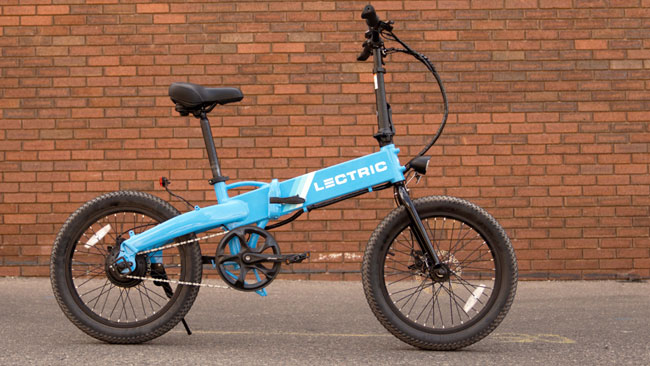 Home > All Green Living > Sustainable Transportation Guide
Home > All Green Living > Sustainable Transportation Guide
Sustainable Transportation Guide
Top Resources for Greening Your Commute
Updated: March 22, 2024
This article provides resources for choosing sustainable transportation options and driving tips for improving fuel efficiency.
SECTIONS: sustainable transportation trends, greener ways to get around, sustainable fuel vehicles, improving fuel efficiency
Sustainable Transportation Trends
Sustainable alternative transportation plays a crucial role in today's world, where environmental concerns and the need for efficient urban mobility are increasingly pressing. By embracing transportation modes like cycling, walking, public transit, and electric vehicles, we are starting to lower our carbon footprint, improve urban air quality, and mitigate the effects of climate change.
Electric Vehicles (EVs):
- Global Sales Increase: The sales share of electric cars worldwide has seen a considerable increase, tripling from 4.2% in 2020 to 14% in 2022. The European Union (EU) and China have witnessed even more significant growth, with electric cars accounting for 21% and 29% of car sales, respectively, in 2022. Norway leads the way, with 88% of its 2022 car sales being electric models.
- Rapid Growth in Specific Segments: The sales of electric two and three-wheeler vehicles, particularly popular in emerging and developing economies, have grown significantly. More than half of India’s three-wheeler registrations in 2022 were for electric vehicles. There's also a noticeable increase in the sales of electric light commercial vehicles and buses.
Bike Lanes and 15-Minute Cities:
- 15-Minute City Concept: This concept aims to ensure that residents can access essential services like healthcare, schools, grocery stores, and jobs within a 15-minute walk or bike ride. For example, Cleveland, OH, seeks to provide equitable access to such amenities for all residents, including those without cars.
- Implementation Examples: Portland, Oregon, has embraced the concept since 2010, aiming for 90% of the city to easily walk or bicycle to meet basic, daily non-work needs by 2030. Cedar Rapids, Iowa, also aims for all core neighborhoods to meet residents' needs within a 15-minute walk or bike ride by 2030.
Electric Bicycles:
- Market Growth: The e-bike market was valued at $27.22 billion in 2021 and is projected to grow to $54.48 billion by 2027 and $118.6 billion by 2030. The market is expected to experience a Compound Annual Growth Rate (CAGR) of between 10.5% and 12.26% during this period.
- Sales Increase: There were 3.7 million e-bikes sold in 2019, and it's estimated that there will be 300 million e-bikes in use worldwide by 2023. Annual sales are projected to rise to 10 million by 2024 and reach 17 million by 2030.
- Price Reduction: The average price of e-bikes sold in the US was $1,825 in 2022, a 10% reduction from the average price in 2021.
These developments indicate a strong trend towards more sustainable and accessible transportation options globally. However, challenges such as infrastructure development, financial support, and technological limitations still need to be addressed to maintain and accelerate this growth.
Greener Ways to Get Around
- Choose a home within walking or biking distance of work and stores whenever possible. You can enter an address into the Walk Score to determine the walkability of a neighborhood.

- Walk or bike to nearby errands whenever possible. Electric bicycles have added a fun and easy way to get around town.
- Take public transportation whenever possible. If you don't have a current public transit schedule for your area, locate one today (check online first) so that you are more likely to use it in the future. Also, plan a fun public transit trip with family or friends to get comfortable with the system.
- Planning a trip or vacation? The Common Forms of Green Transportation Guide provides great tips to lower your carbon footprint.
- Join a carpool. If your company doesn't coordinate carpooling, ask them to consider it or coordinate it yourself. If possible, coordinate carpooling with nearby businesses. Two ways to find carpooling opportunities: Carpoolworld and Craigslist (select your location and click on 'rideshare' under the 'community' section).

- Consider switching to car-free (or car-light) living.
- Find out if a "shared transport" option such as carsharing, bikesharing, peer-to-peer ridesharing, on-demand ride services, or microtransit will work for you.
- If feasible, encourage your children to walk or bike to school. If safety is an issue, consider launching a Safe Routes to School program.
Sustainable Fuel Vehicles
- Search tools for finding an electric, hybrid or other sustainable fuel, low emission vehicle:
- Tool for calculating savings by replacing your current car with a more fuel-efficient or electric car.
Improving Fuel Efficiency
In addition to adopting sustainable transportation modes, the importance of driving in a way that improves fuel efficiency cannot be overstated. Eco-driving practices include maintaining steady speeds, avoiding rapid acceleration and heavy braking, and keeping the vehicle well-maintained. These practices not only reduce fuel consumption but also lower emissions and reduce fuel costs.
- Edmunds.com tested out popular fuel-saving tips and found the most effective:
- Slow down acceleration time (accelerate 0 to 60 mph in 15 seconds). Average improvement in fuel economy: 31% (highest: 37%)
- Drive the speed limit. Average savings: 12% (highest: 14%). In general, optimum miles per gallon are found at 35-45 mph.
- Use cruise control (unless driving in a mountainous area). Average savings: 7% (highest: 14%)
- Shut down the car if idling for more than 1 minute. Savings up to 14%
- Keep tires inflated to recommended levels. Savings varied but, in general, mileage decreased by 1% per pound below recommended tire pressure.
- Turning off the A/C and opening the sunroof. Minimal savings, but could vary by vehicle. (Note: they found no difference if the A/C was turned off and the windows were rolled down because of the increased drag on the car).
- Refuel your vehicle during the evening hours to reduce the amount of pollution created.
- Combine errands and plan out the shortest route possible. The heaviest car emissions occur during the first two miles that a car is driven (while the engine is still cold). Whenever possible, walk or ride your bike.

- If buying a car, only purchase optional equipment if needed (especially heavy equipment that can lower fuel efficiency). Avoid the real fuel guzzlers: automatic transmissions, larger, more powerful engines, power steering, air conditioning, and 4-wheel drive.
- Keep your tires inflated at the maximum recommended pressure(check once a month) and properly aligned (get your alignment checked every 5,000 miles)
- Purchase long-lasting, fuel-efficient Radial tires (vs. Bias or Belted tires)
- Keep up on your car maintenance, especially ignition timing, spark plugs and wiring, and idle speed setting (a poorly tuned car can lose up to 20% fuel efficiency)
- Watch your mileage for problems.
- If you own more than one vehicle, try to use the one with the best mileage and lowest emissions whenever possible.
- If your car runs on gasoline, avoid buying a higher octane gasoline than your engine needs (producing higher-octane fuels uses more crude oil than the lower octane gasoline, and may often involve the use of toxic substances, which means the environment suffers). Consult your owner's manual for the right grade to use.
- Avoid quick starts and stops. In general, drive as smoothly as possible.
- Use cruise control to maintain a steady speed when possible.
- Keep windows shut at high speeds.
- Don't start your car until you are ready to drive off.
- If you drive a car with a manual transmission, upshift at the lowest speed possible to reduce fuel consumption.

- Use multi-grade, energy-conserving (EC) motor oil to improve fuel efficiency by 1-2% or buy re-refined oil to support the recycling of oil. Purchase the lowest viscosity oil (i.e., "10 W 40") recommended by your car's owner's manual. Check your vehicle's user manual to determine how often to change your oil (typically 5,000 to 15,000 miles ). Recycle your used motor oil and oil filters at an approved collection center and sop up any spills with super-absorbent towels or kitty litter.
- Have your air conditioner serviced by a trained mechanic with access to a "vampire" machine, which recycles freon. These machines drain the coolant, purify it, and reinject it into the air conditioner. Fix leaks.
- Use antifreeze which does not contain ethylene glycol
- Avoid idling your car for more than 30 seconds.
- Avoid carrying unnecessary, heavy items around in your car. On trips, avoid using roof racks, car-top packs, or towing a trailer if at all possible. Every one hundred extra pounds in the vehicle increases the amount of fuel used.
- Use the overdrive feature if available.
- Keep the air and fuel filters clean.
- Also, to avoid polluting the groundwater with leaking fluids, periodically check for and fix any leaks.
MORE
